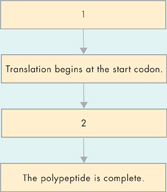13 Study Guide
 Information and Heredity
Information and Heredity
Messenger RNA, transfer RNA, and ribosomal RNA work together in prokaryotic and eukaryotic cells to translate DNA's genetic code into functional proteins. These proteins, in turn, direct the expression of genes.
13.1 RNA
 The main differences between RNA and DNA are that (1) the sugar in RNA is ribose instead of deoxyribose; (2) RNA is generally single-stranded, not double-stranded; and (3) RNA contains uracil in place of thymine.
The main differences between RNA and DNA are that (1) the sugar in RNA is ribose instead of deoxyribose; (2) RNA is generally single-stranded, not double-stranded; and (3) RNA contains uracil in place of thymine.
 In transcription, segments of DNA serve as templates to produce complementary RNA molecules.
In transcription, segments of DNA serve as templates to produce complementary RNA molecules.
13.2 Ribosomes and Protein Synthesis
 The genetic code is read three “letters” at a time, so that each “word” is three bases long and corresponds to a single amino acid.
The genetic code is read three “letters” at a time, so that each “word” is three bases long and corresponds to a single amino acid.
 Ribosomes use the sequence of codons in mRNA to assemble amino acids into polypeptide chains.
Ribosomes use the sequence of codons in mRNA to assemble amino acids into polypeptide chains.
 The central dogma of molecular biology is that information is transferred from DNA to RNA to protein.
The central dogma of molecular biology is that information is transferred from DNA to RNA to protein.
13.3 Mutations
 Mutations are heritable changes in genetic information.
Mutations are heritable changes in genetic information.
 The effects of mutations on genes vary widely. Some have little or no effect; some produce beneficial variations. Some negatively disrupt gene function.
The effects of mutations on genes vary widely. Some have little or no effect; some produce beneficial variations. Some negatively disrupt gene function.

 Mutations often produce proteins with new or altered functions that can be useful to organisms in different or changing environments.
Mutations often produce proteins with new or altered functions that can be useful to organisms in different or changing environments.
13.4 Gene Regulation and Expression
 DNA-binding proteins in prokaryotes regulate genes by controlling transcription.
DNA-binding proteins in prokaryotes regulate genes by controlling transcription.
 By binding DNA sequences in the regulatory regions of eukaryotic genes, transcription factors control the expression of those genes.
By binding DNA sequences in the regulatory regions of eukaryotic genes, transcription factors control the expression of those genes.
 Master control genes are like switches that trigger particular patterns of development and differentiation in cells and tissues.
Master control genes are like switches that trigger particular patterns of development and differentiation in cells and tissues.
operon (377)
homeotic gene (382)
operator (378)
homeobox gene (382)
RNA interference (380)
Hox gene (382)
differentiation (381)
Think Visually Using the information in this chapter, complete the following flowchart about protein synthesis:
Table of Contents
- Formulas and Equations
- Applying Formulas and Equations
- Mean, Median, and Mode
- Estimation
- Using Measurements in Calculations
- Effects of Measurement Errors
- Accuracy
- Precision
- Comparing Accuracy and Precision
- Significant Figures
- Calculating With Significant Figures
- Scientific Notation
- Calculating With Scientific Notation
- Dimensional Analysis
- Applying Dimensional Analysis





